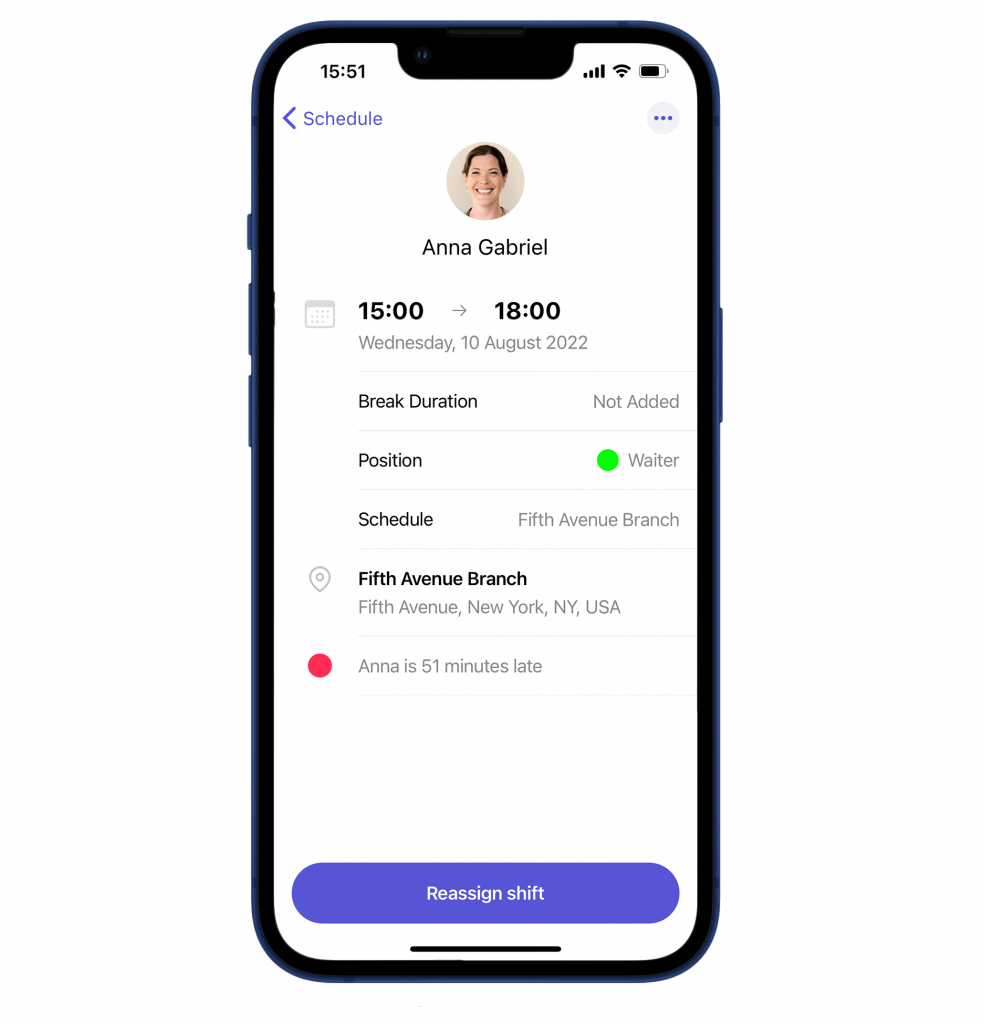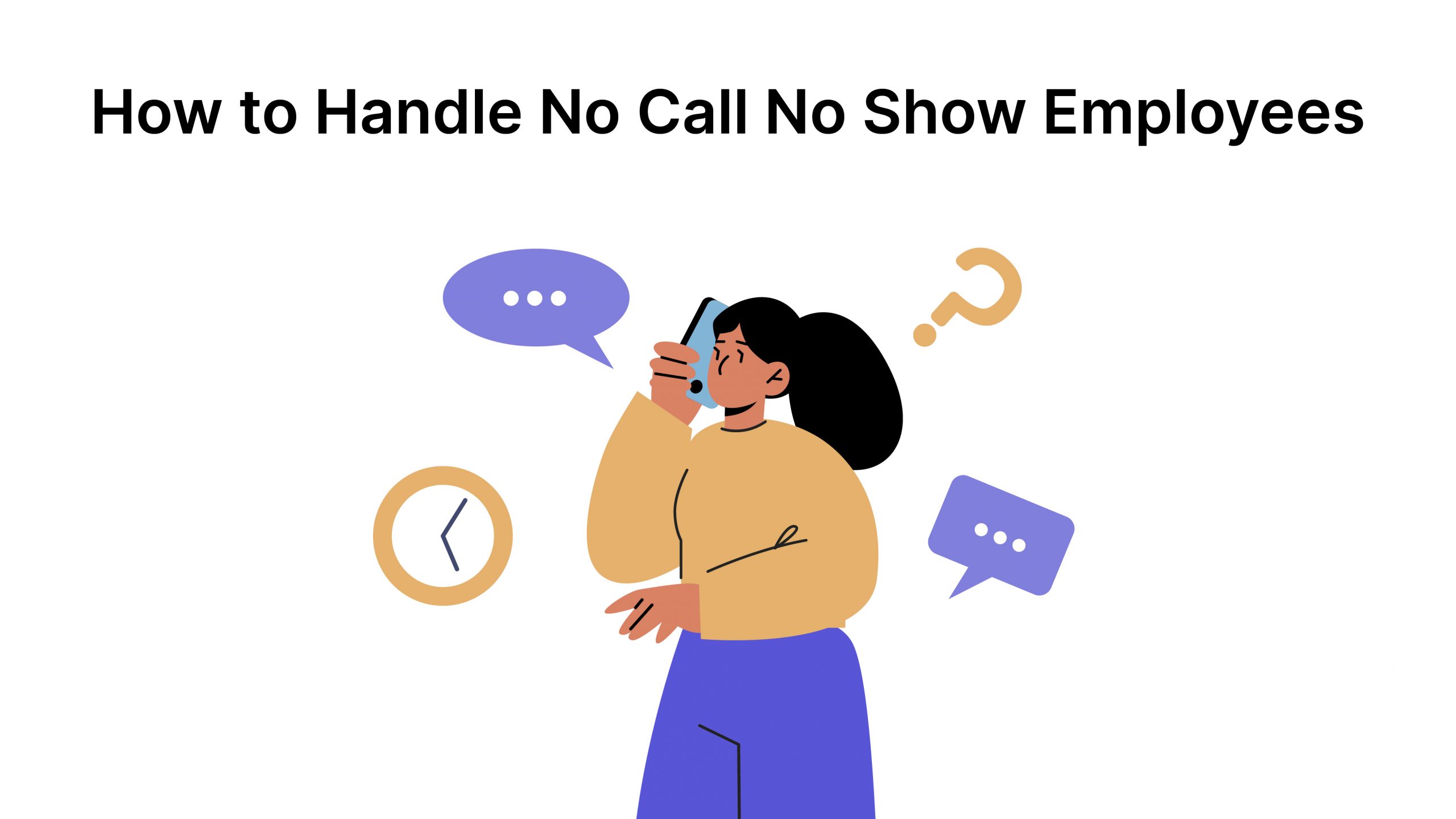How to Handle No Call, No Show Employees
What should you do if a shift starts and the employee in charge doesn’t show up and doesn’t even call? It’s frustrating to face these “no call no show” incidents.
Finding a substitute at the last minute is certainly unpleasant. Sometimes, you have to cover for the employee or leave your business understaffed. Understaffing means a poorer customer experience and decreased morale among other employees.
Whether the employee does that on purpose or they’re truly in an emergency, you need to be prepared for what to do next.
In this post, we’ll give you tips on how to handle no call no show and how to write a no call no show policy for your business.
What is a no call no show?
No call no show means an employee doesn’t show up for their scheduled shift without calling or messaging the employer.
Normally, workers must inform their absences in advance so the employer has enough time to find substitutes. But no call no show happens. People may get into a car accident or have a heart attack. There’s no way to tell the employer about the absence right away.
But sometimes, no call no show occurs because employees oversleep or don’t feel like working. In these cases, they have to face disciplinary actions such as warnings for violation, suspension, or termination.

How to create a no call no show policy
A no call no show policy includes the employer’s expectations towards employee attendance & the consequences of no call no show.
Define expectations for employees
Lay out in the policy what you expect your employees to do:
- How far in advance employees are expected to request time off
- How far in advance employees are expected to notify the employer about their absences in case of emergencies
- Define no call no show, acceptable reasons for it, and acceptable documentation employees need to submit once they’re back
For example:
Employees are expected to request time off at least 1 week in advance. In case of emergencies, employees are required to notify the employer at least 30 minutes before the scheduled shift via call or text.
A no call no show occurs when an employee fails to show up for a scheduled shift and doesn’t notify [Your Company Name] about the absence. After 15 minutes from the start of the shift, the event counts as one no call no show offense.
If an employee has a valid reason for their no call no show, they need to provide acceptable proof within a certain time frame. Acceptable proof includes doctor’s notes and must be provided within the day of returning to work.
Determine disciplinary actions
For each no call no show offense, employees have to face disciplinary actions.
Some businesses adopt a zero-tolerance policy — employees are terminated right away if they violate the no call no show policy. However, since not everyone disappears intentionally, it’s recommended to give employees 2 chances before termination.
But that doesn’t mean no-call-no-show employees can get away with the first two violations. They have to face milder disciplinary actions such as verbal or written warnings, salary deduction, or suspension.
If an employee doesn’t show up and fails to contact the supervisor within a certain number of consecutive days, that will be considered as voluntary termination.
For example:
A no call no show will result in the disciplinary actions below:
- First offense: Verbal warning
- Second time: Written warning via email
- Third time: Termination
If the no call no show employee fails to contact the employer within 3 days after the no call no show incident, it’s considered voluntary termination by the employee.
Define steps to take when someone doesn’t show up
This section lists the specific steps you’ll take if an employee doesn’t show up:
- Call the employee
- Call the employee’s emergency contact list
- If someone picks up their phone and you find out the reason for the no call no show, you can decide what to do next.
- If the employee is in an emergency, see if you can provide support.
- If the employee doesn’t have an acceptable reason, find a substitute first and enforce disciplinary actions later.
- Check if the employee is using any type of leave or PTO
- Try leaving a voicemail message, for example, “Hi, you didn’t show up at work today. I’m calling to make sure you’re ok. Call me back and let me know.”
Besides the immediate actions after finding out someone doesn’t show up for work, you should establish procedures for disciplinary actions. Should you send an email after the incident? How do you arrange a conversation with the employee if they come back? How do you keep records of the incidents?

Ensure your policy is compliant
To make sure your policy is compliant, always check the federal, state, and local employment laws, and consult a legal expert.
Communicate the policy to employees
After establishing your no call no show policy, communicate it to your workforce. You can do this during the onboarding process, training sessions, team catchups, or one-on-one conversations.
During these conversations, employees can ask questions, raise concerns, or give suggestions. This way they’re more engaged and they can understand the reasoning behind the policy.
To make sure employees understand the company’s expectations and keep them accountable, get employees to sign an acknowledgment that they’ve read, understood, and agreed to be bound by the policy.
Making the policy accessible to everyone is also necessary. Put it in the employee handbook, company intranet, or bulletin board so employees can refer to the rules when they need.
Tips to handle no call no show
Be consistent & don’t bias
Unequal enforcement can be viewed as discriminatory, which can result in complicated lawsuits. Once you’ve set the rules, you need to enforce them fairly and consistently.
That means avoiding going bananas at employees with a bad track record and favoring employees with good performance. Someone with a bad track record can come across emergencies, and those with good performance can violate the policy thinking you’ll let them pass anyway.
Prepare an on-call list
An on-call list includes workers who are willing to cover for sudden absences. There are always people who want to work extra hours, and they’ll be helpful in case someone doesn’t show up for their shift.
This list also lets you know which staff members are always willing to work when problems arise. That can be a signal that they’re reliable enough to be praised, rewarded, and promoted.
What if your current employees aren’t fond of being on-call and working extra hours? You may need to offer a higher rate for those emergency hours as incentives, or hire extra people.
If your employees are required to stay on the premise or so close to the workplace that they can’t use their time freely, you may need to compensate for their on-call hours.
Get to know your employees
No call no show sometimes stems from disengagement. Disengagement may come from personal issues, workplace conflicts, dissatisfaction with the work environment, or feeling unappreciated.
By observing your workforce and getting to know them, you can spot problems and find solutions for them timely. For example, you can provide support for struggling employees, resolve team conflicts, offer incentives or awards to show appreciation, or allow shift swapping for those with tight schedules.
Talking to employees with high absenteeism is also crucial. Disengaged employees may not be willing to share the real reason behind their attendance problems, but you might get some insights from those conversations. Remember to enter the talk with compassion and calmness.
Building relationships with employees doesn’t mean they’ll bond with you and never violates the company’s policy, but certainly will change the workplace culture for the better.
Keep records of relevant documentation
Mention in your policy that employees have to submit documentation to prove that their absences are legitimate. For example, a doctor’s note or evidence of a health condition.
If you terminate an employee due to no call no show, you should keep records of all incidents so no one can sue you for wrongful termination.
If an employee just disappears and never returns to work, send them an email stating that your company has considered them to have abandoned their job and voluntarily resigned.
Use your judgment skills
No matter how meticulously you craft your policies, sometimes it’s just hard to decide which disciplinary action to take.
What if an excellent employee violates the policy for the third time? Can you reinstate an employee who shows up after their disappearance and you’ve sent them a notice of termination? Is it too harsh to fire someone?
If an employee already violates the rules multiple times within a time frame, they’ll be very likely to violate again. Or not…

You’ll just have to use your own judgment to say what’s right. And if you’re wrong, it’s just the limitation of humans. We’re not always right.
If solely using your policy sounds too strict, you can consider the employee’s past performance and attendance records. If you’re not so sure, seek guidance from a legal expert to avoid decisions that may appear discriminatory.
Improve your attendance system
Your attendance system should give you a quick look at the real-time attendance status of your business, so you can act quickly in situations such as no call no shows. For example, it’ll be useful if you receive alerts when someone hasn’t shown up at work, then you can find substitutes right away.
A flexible attendance system allows you to apply a generous time-off policy where employees can request time off easily. If people feel like it’s too complicated to ask for time off or their leave requests won’t be accepted, they’re more likely to disappear instead.
A decent attendance system also benefits employees. For example, they can receive shift reminders so they don’t forget work time. They can swap shifts with someone else. Or they can send a message asking someone to help cover their shift.

FAQs around no call no show
Why do you need a no call no show policy?
A no call no show policy lays out what are expected of employees in terms of attendance and the repercussions of no call no show. Employees know what will happen if they don’t show up, which can help reduce malpractices and absenteeism.
This type of policy also serves as guidelines for employers when no call no show incidents happen. Employers know exactly what steps they need to take if an employee disappears without any notice.
What to say to an employee who doesn’t show up for work?
If a no call no show employee returns to work, you should have a conversation with them to:
- Discuss the importance of the employee to your business operations and how their no call no show affects both the business and other employees.
- Ask the employee to explain why they didn’t show up for work.
- If it’s a legitimate reason, ask them to provide the proof (if they haven’t done so).
- If it’s not an acceptable reason, reprimand them.
- State the consequences of that no call no show offense and the next offense.
- State your expectations towards their attendance in the future.
How many no call no shows does it take to get fired?
Some workplaces apply a zero-tolerance policy, meaning the first no call no show offense immediately results in employment termination. But businesses often use the “3-strike” rule where the third offense will result in termination.
What are acceptable reasons for no call no show?
Acceptable reasons include emergencies such as car accidents or trips to the ER — situations in which it’s impossible to call.
There aren’t many excuses that are reasonable enough when access to a cell phone is so easy these days. Still, it’s best to consider the reasons on a case-by-case basis before making any decision.
Can you fire a no call no show employee?
An employer can fire a no call no show employee. But you shouldn’t do so before finding out the actual reason behind that violation.
Also, employees are entitled to sick leave, Family Medical Leave Act (FMLA) leave, or American with Disabilities Act (ADA) leave. If you fire an employee while they’re using one of those leaves, they may have a strong case to report that they were terminated due to retaliation.
No call no show vs job abandonment?
If an employee comes back to work after their silent absence, that is a no call no show. If they don’t come back anymore, that is job abandonment.
How to write up an employee for no call no show?
If an employee has violated the no call no show policy repeatedly and you have to write up them, include these details in your write up form:
- Notify employee that they broke the company policy repeatedly with their no call no show attempts
- Details of the violations: date & time, what happened
- Consequences of the no call no show: termination
Takeaway
Handling no call no show and establishing a policy for it may seem daunting. But once you’re prepared for it, you know exactly what to do next.





